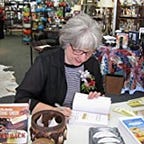Developing an Artistic Eye — Seeing is Both Visual and Perceptual
#3 — Learning to see like an artist
“If the artist has outer and inner eyes for nature, nature rewards him by giving him inspiration.” — Wassily Kandinsky
I was inspired to create the fiber art shown above from noticing the tiny weed-like flowers that grew between the cracks of my sidewalk’s paver stones. The very delicate plant contrasted deeply with the hard surface that doubled as a complementary background.
As a fiber artist, over the years I’ve had to learn how to develop my ability to see ordinary things through an artistic eye. It’s been an ongoing process and one I enjoy immersing myself in often. I’d like to share some of the things I’ve learned with you.
The Artist’s Eye
We all have this to some extent. We use a facet of this ability when we arrange our home decor or mix and match our clothing choices. We use our sense of position, balance, color, shape, and compatibility.
My long relationship with fabric has given me an arena to expanded on that ability by learning to appreciate the texture, finish, color, and pattern combinations.
For those of us who strive to turn our love of fabric into a higher level of artistic application, we need to realize that it takes training and practice to develop a creative ‘Artist Eye’. In short, we have to change the way we see and rewire our brains to accept our specialized vision.
What we see is never all there is
Believe it or not, our brains are often our biggest hindrance. With experience and time, our brains learn to anticipate and make decisions about what we see without any conscience effort on our part.
So how is that a hindrance to an artist? Our brains function on a level of practicality and efficiency. For instance, upon seeing the dessert in the photo below and identifying it as fruit sorbet, the brain thinks its work is done and ceases to look for further information.
It’s that missing information that is absolutely necessary to an artist, no matter the medium they choose to work in. To develop an ‘Artist’s Eye’, we need to first see the whole scene or vignette, and then the subtle details the scene reveals. That will give us both the visual and the perceptual feeling we need to render the scene as a piece of art.
For example, let’s revisit the two goblets of sorbet. The brain took the expedient route to identify the objects and stopped there. But, what would a brain that is trained to see in conjunction with an ‘Artist’s Eye’ tell us?
• The mood of the scene is tranquil, with an ‘old home place’ feel, because the fruit is sitting on a worn and weathered wood plank. We can imagine it’s part of a back porch step.
• The mid-morning sun is bathing the fruit in a clear, bright light. I say mid-morning because of the angle of the shadow cast by the goblet. The speckled patches of light create both highlight and shadow as well as tonal color changes. The strong splashes of light create different values and hues in the basic three colors — peach, brown, and green.
• A romantic aura is set by the delicate flower of peach slices arranged in the middle of the sorbet.
• A sense of freshness and purity is conveyed by the healthy and vibrant green of the mint plant and its leaves used as a garnish.
• All these elements are present: Hard surface of the wood, Sharp angles in the deep shadows, soft curves, definitive lines, color value, warmth and coolness, mood, texture, pattern.
These things are present but not initially registered by the brain. We, the artist, must prod the brain to see these things. If practiced enough, the brain will begin to adapt to our ‘Artist Eye’.
